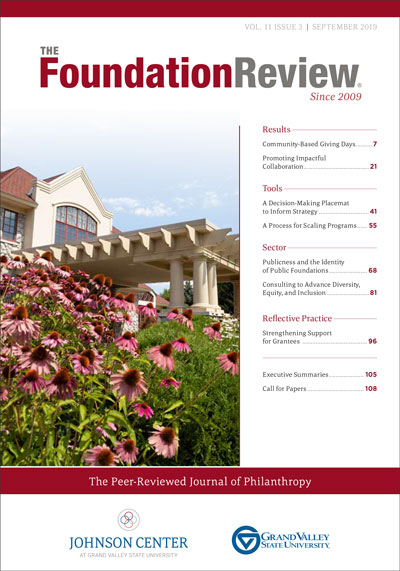Impactful Collaboration, DEI Consulting, and More


 The latest issue of The Foundation Review covers a broad range of topics related to the work of philanthropy, from evergreen challenges to emerging approaches to supporting work in communities. We hope you will find something you can use in these articles as you address challenges old and new.
The latest issue of The Foundation Review covers a broad range of topics related to the work of philanthropy, from evergreen challenges to emerging approaches to supporting work in communities. We hope you will find something you can use in these articles as you address challenges old and new.
Not yet a subscriber? Click here to start your free 90-day trial.
Looking at one of the perennial challenges in philanthropy, Easterling and McDuffee examine the Health Foundation of Central Massachusetts’ experience in supporting collaboration. Through interviews with representatives from successful projects, they identified ways in which the foundation was able to support collaborative efforts in ways that increased impact. They also emphasize that it requires high levels of commitment and the capacity to analyze data.
Diversity, equity, and inclusion (DEI) represents a long-standing challenge to philanthropy that in recent years has begun getting the focused attention it needs. Reporting on work done as part of an initiative by the National Network of Consultants to Grantmakers, Clohesy, Dean-Coffey, and McGill interviewed consultants about how they have effectively partnered with foundations to advance DEI. Consultants found that they need to help foundations refine their definitions of DEI and put them in the context of the foundation’s mission, vision, and values as they work with foundation staff.
How to effectively engage board members in strategic planning is yet another evergreen issue. Mitton, Mundorf, Putnam-Walkerly, and Krey developed a decision-making placemat tool to engage the board members of the Sisters of Charity Foundation of Cleveland in revising the strategy for the foundation’s place-based program. The tool used scenarios to guide board members toward consensus. After using the tool, board members were better able to articulate the rationale for the shift in strategic direction.
One of the more recent approaches to community philanthropy has been the emergence of community giving days. Typically spear-headed by a community foundation, giving days are an opportunity to encourage philanthropy within a geographic community and raise awareness of the work of nonprofit organizations. Humphries Brown and Bhati analyzed the impact of these giving days and found that while the total amount of giving increased between 2009 and 2016, the median amount dropped and the range widened. While the number of giving days is increasing, and they may help increase the number of donors, the expectation about how much money they will raise in any given community should be modest.
How to scale successful programs is another frequent challenge in the sector. Maxwell and Richman describe a process called SPREE — Scaling Programs with Research Evidence and Effectiveness — that has been found to help grantees scale successfully. Efforts to scale programs need to assess both which interventions are likely to be successfully scaled and which organizations are ready to engage in scaling programs. Systematic use of evaluation is key to success.
As critiques about philanthropy have increased in recent years, Williamson and Luke’s exploration of the ways in which a foundation is “public” raises important considerations. They investigated the ways Australia’s public ancillary funds understand their identity as public foundations and examined how perceptions of publicness inform and influence the practice, conduct, and identity of grantmaking foundations. Two dimensions of publicness were significant: donations, or public money; and grantmaking, or public benefit. Community foundations in the U.S. are similarly situated, needing to consider both dimensions in order to achieve the goal of transparency.
While funders often see a big part of their role as strengthening the nonprofits they support, Bettis and Pepin explore issues that are emerging as nonprofits are tasked with addressing systems change. Funders must take into account the dynamic social systems within which the nonprofits they fund aim to effect change. Funders that build partnerships, recognize and respond to grantee business models, ease reporting burdens, and leverage their power to convene are more likely to make significant contributions to improving the resiliency of communities.